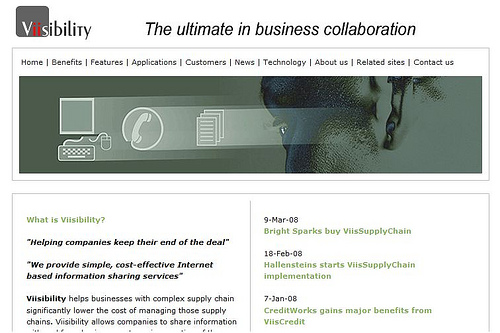 Ben Kepes drew my attention to Viisibility, which appears to be a very interesting web based supply chain management / data clearing-house / hub type of a business.
Ben Kepes drew my attention to Viisibility, which appears to be a very interesting web based supply chain management / data clearing-house / hub type of a business.
At first reading I completely misread the name, thinking it was Visibility. Wow, what a great choice, I thought – a simple, common word that perfectly describes what the business is all about. But wait! try to Google it: it’s a bit difficult to find the relevant entries from the 47,100,000 hits Goggle found… That brings up question number one:
Do common words that describe your business perfectly but are hard to Google make good brands?
Robert Scoble has a simple rule: only pick names that do not come up on the major search engines at all.
But as it turns out I was wrong, just missing that extra “i”: the name is actually Viisibility. That brings up a whole new issue, which is my question number two:
Can intentionally misspelled common words that in pronunciation describe the product, but are only available as domains and are only unique on search because of the “typo” actually become Brands?
Last time I asked the question, the majority vote was yes (albeit with few participants). I used Vyew as an example, which I still think is a good name. But Viisibility’s case is a bit more complex, as shown by these two homepages:
- Viisibility: managing supply chains.
- Visiblity: ERP for Complex Manufacturing.
Oops. Not only there’s another company with a similar name, they are also in the same space, “differentiated” only by a typo. I’m afraid it’s not much of a differentiation, I can’t help but think Viisibility is a poor choice for a brand.
But forget the extreme case above, I’d like to return to the generic question, and run the poll again, especially as I’ve gained a few marketers as readers since last time. If you read this in a feed reader, there’s a chance the poll does not work, so please click through the blog title to vote:
Update (4/22): The Importance of a Good Name @TechCrunch.





Recent Comments